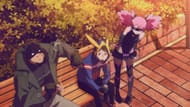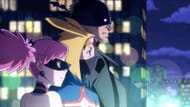My Hero Academia: Vigilantes has recently started its anime run and has put this spinoff at the forefront of the franchise at the moment, leading to a lot of discussions regarding the trope of the vigilante. While some people might think otherwise, this trope is different to that of the antihero, although it is easy to understand that there is confusion about it.
The concept of the vigilante is quite clear in a series that is titled My Hero Academia: Vigilantes, but it goes beyond just working outside the law to work as an antihero. It is defined by the moral code of the character in question, and how far they are willing to go to achieve their goals, even if they are valid, which contrasts heavily with the protagonist of this series, Koichi Haimawari.
Disclaimer: This article contains spoilers for the series. Any opinion expressed here belongs to the author.
My Hero Academia: Vigilantes explains the difference between a vigilante and an antihero

As the name of the series suggests, My Hero Academia: Vigilantes is about the titular vigilantes, who are heroes who work outside of the law without a license to help others. This is most noticeable with the protagonist, Koichi Haimawari— also known by his hero title The Crawler— who never took the exams to enter UA and helps people around him without a license.
A lot of people have assumed that a vigilante is similar to an antihero, often citing examples from the likes of Marvel and DC Comics, such as The Punisher and Red Hood, respectively, since they don't hesitate to work outside of the law and take the lives of villains. However, while antiheroes often break the law to do what they do, thus sharing similarities, the difference lies in their ideologies.
When taking into account characters such as Koich or Knuckleduster in My Hero Academia: Vigilantes, they attempt to help people, and their morals are not that different from licensed heroes in the series. If anything, their roles as vigilantes highlight that there is always a way to help people in the long run.
The moral compass when it comes to heroism

My Hero Academia: Vigilantes, much like the original series, deals heavily with the idea of what makes a hero, and Koichi's own journey is a testament to that, since he doesn't have the proactive nature to achieve his dream initially.
It is through the events of the series, coupled with the likes of Knuckleduster and Pop Step, that he begins to learn what it means to be a hero, which is something he can do whether it's with a license or as a vigilante.
Antiheroes usually work outside of the law, but that isn't always the case since they are defined by making morally questionable actions for what they consider a greater good. A good example of that could be shown in Lady Nagant's backstory when she had to take extreme measures for the well-being of society, although that ended up breaking her emotionally.
Final thoughts
My Hero Academia: Vigilantes makes a clear distinction between what it means to be a vigilante and an antihero, which is something that a lot of people may not understand. It also makes an emphasis on the fact that what matters the most is helping people.
Related articles:
- My Hero Academia: Vigilantes anime needed to air before the final season (& it could make the ending better)
- Tomura Shigaraki is My Hero Academia's most misunderstood character (& his origins show why)
- My Hero Academia's most beloved Pro Heroes all have a key trait in common (& fans never realized)
- Does the Heroes Rising movie contradict My Hero Academia's ending? Explored
